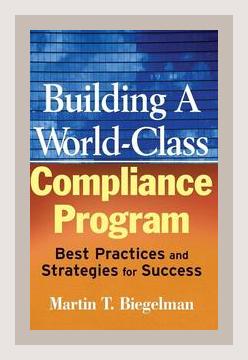Business Law and EthicsRegulatory Compliance
Building a World-Class Compliance Program: Best Practices and Strategies for Success
Author: Martin T. Biegelman
Published: 2008
Category: Regulatory Compliance
Introduction
Martin T. Biegelman’s “Building a World-Class Compliance Program: Best Practices and Strategies for Success” serves as a comprehensive guide for organizations aiming to establish robust compliance frameworks. This guide provides actionable strategies and best practices that can help businesses adhere to legal and regulatory standards while promoting ethical practices at all levels. This summary captures the core ideas, specific examples, and practical actions proposed in the book.
1. Understanding Compliance and Its Importance
Major Point:
Compliance is not just about obeying the law; it encompasses ethical conduct and corporate governance.
Concrete Example:
Biegelman discusses the financial scandals of the early 2000s, such as Enron and WorldCom, highlighting how lapses in compliance can lead to devastating consequences for stakeholders.
Action Step:
Conduct a comprehensive compliance audit to identify gaps in your current practices. Ensure that compliance extends beyond merely following laws to include promoting a culture of ethics within the organization.
2. Establishing a Compliance Program
Major Point:
The foundation of a world-class compliance program is a well-documented framework tailored to the specific needs of the organization.
Concrete Example:
Biegelman outlines the components of an effective compliance program: clear policies and procedures, effective training, and a system for reporting and addressing non-compliance.
Action Step:
Draft a compliance manual and distribute it organization-wide. This manual should detail all relevant policies, procedures, and compliance expectations.
3. The Role of Leadership in Compliance
Major Point:
Leadership commitment is crucial for a successful compliance program.
Concrete Example:
The book describes how CEOs and senior management who visibly support compliance initiatives create a culture of integrity. Biegelman points to companies like J&J, where top leadership actively participates in compliance training.
Action Step:
Senior executives should frequently communicate the importance of compliance in company-wide meetings and lead by example by undergoing regular compliance training themselves.
4. Risk Assessment and Management
Major Point:
Identifying and managing risks is a critical component of compliance.
Concrete Example:
Biegelman details a multi-step risk assessment process, including risk identification, evaluation, and mitigation.
Action Step:
Implement a continuous risk assessment process that involves regular evaluations of both internal and external risks. Use tools like risk matrices to prioritize and address these risks.
5. Creating Policies and Procedures
Major Point:
Policies and procedures must be clear, concise, and accessible to all employees.
Concrete Example:
The book gives an example of tailoring procedures to different departments so that each policy aligns with specific operational realities.
Action Step:
Develop department-specific policy documents that outline compliance expectations relevant to each function. Ensure these documents are easily accessible on an internal portal.
6. Training and Education
Major Point:
Effective training programs are essential for instilling compliance-related knowledge and skills.
Concrete Example:
Biegelman highlights a case where a multinational corporation saw a significant improvement in compliance adherence following the implementation of an online training program.
Action Step:
Create a mandatory, interactive compliance training program for all employees. Include real-life scenarios and quizzes to reinforce understanding.
7. Communication Strategies
Major Point:
Open and ongoing communication about compliance is vital to maintaining its importance.
Concrete Example:
The book discusses a scenario where monthly newsletters about compliance helped keep the topic at the forefront of employees’ minds.
Action Step:
Issue a monthly or quarterly compliance newsletter that includes updates on policies, real-world case studies, and reminders on the importance of compliance.
8. Monitoring and Auditing
Major Point:
Regular monitoring and auditing ensure that compliance programs are effective and identify areas for improvement.
Concrete Example:
Biegelman presents a compliance audit checklist used by an international bank to ensure adherence to policies and identify emerging risks.
Action Step:
Set up a regular schedule for internal audits and compliance reviews. Use a standardized checklist to maintain consistency and thoroughness.
9. Responding to Non-Compliance
Major Point:
Organizations need a structured approach for handling instances of non-compliance.
Concrete Example:
The book outlines a case where a company rapidly responded to a compliance breach by conducting an internal investigation, identifying the root cause, and implementing corrective measures.
Action Step:
Develop and circulate a non-compliance response protocol that details steps for investigation, documentation, disciplinary actions, and preventive measures.
10. Building a Compliance Culture
Major Point:
A culture of compliance extends beyond formal policies and requires the engagement of the entire organization.
Concrete Example:
Biegelman elaborates on how companies with strong compliance cultures often have fewer incidents of fraud and regulatory breaches.
Action Step:
Foster a speak-up culture where employees feel comfortable reporting unethical behavior without fear of retaliation. Implement anonymous reporting systems to support this initiative.
11. Leveraging Technology for Compliance
Major Point:
Technology can greatly enhance the efficiency and effectiveness of compliance programs.
Concrete Example:
The book describes the use of compliance management software that helped a Fortune 500 company streamline its compliance processes.
Action Step:
Invest in compliance management software to automate monitoring, reporting, and training modules. Ensure the software is scalable and customizable to meet the organization’s specific needs.
12. Continuous Improvement and Benchmarking
Major Point:
Compliance programs should be dynamic and continuously improved to adapt to new challenges.
Concrete Example:
Biegelman cites companies that benchmark their compliance programs against industry standards to identify areas for enhancement.
Action Step:
Regularly benchmark your compliance program against industry best practices and incorporate feedback for continuous improvement. Conduct annual reviews to identify gaps and update policies accordingly.
Conclusion
Martin T. Biegelman’s “Building a World-Class Compliance Program” underscores the complexity and importance of establishing an effective compliance system. By following the strategies and best practices outlined, organizations can not only adhere to regulatory requirements but also foster a culture of integrity and accountability. From leadership involvement to leveraging technology, each element plays a crucial role in the overall success of the compliance program.
